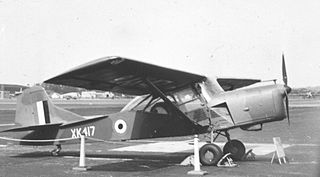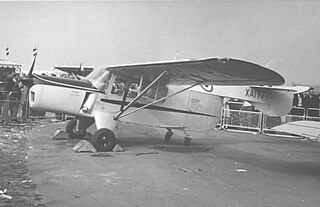
The VEF I-12 was a tandem, two seat Latvian trainer aircraft designed by Kārlis Irbītis and produced by VEF in Riga.

The Miles M.57 Aerovan was a British twin-engined short-range low-cost transport aircraft designed and produced by Miles Aircraft. It was primarily used for freight and passenger services.

The General Aircraft GAL.42 Cygnet II was a 1930s British single-engined training or touring aircraft built by General Aircraft Limited at London Air Park, Hanworth.

The Auster AOP.9 was a British military air observation aircraft produced by Auster Aircraft Limited to replace the Auster AOP.6.

The Miles M.28 Mercury was a British aircraft designed to meet the need for a training and communications plane during the Second World War. It was a single-engined monoplane of wooden construction with a twin tail and a tailwheel undercarriage with retractable main units.

The Chrislea Super Ace is a 1940s British four-seat light aircraft built by Chrislea Aircraft Limited.
The Arpin A-1 was a two-seat low-wing monoplane which was powered by a single radial engine in pusher configuration, mounted behind the cabin between twin booms that carried the tail. An unconventional fixed tricycle undercarriage was fitted. Only one was built.

The Auster B.4 was an unusual British development of the Auster family of light aircraft in an attempt to create a light cargo aircraft.

The Miles M.65 Gemini was a British twin-engined four-seat touring aircraft designed and built by Miles Aircraft at Woodley Aerodrome. It was the last Miles aircraft to be produced in quantity.

The Gloster TC.33 was a large four-engined biplane designed for troop carrying and medical evacuation in the early 1930s. Only one was built.

The Miles M.18 was a single-engine twin-seat low-winged light British civil utility aircraft of the 1930s.
The Miles Merchantman was a scaled-up and four-engined development of the Miles Aerovan light freighter. It flew in 1947 but the design was abandoned when Miles Aircraft was taken over by Handley Page in 1948.
The RWD 18 was a four/five seat STOL utility aircraft designed and built in Poland from 1936.
The Portsmouth Aerocar was a British light utility aircraft design of the late 1940s. It was intended to be an aircraft that could be used for a variety of tasks including transport "mobile office" but only one prototype was built being scrapped in 1950.

The Praga E-210 was a four-seat, twin-engined touring aircraft built in Czechoslovakia in the late 1930s. It had an unusual pusher configuration. Its tail unit and undercarriage were modified significantly before World War II and after the war a more powerful version designated E-211 was flown.
The Blackburn Type E was a development of the earlier Blackburn Mercury single-engined monoplanes, but was innovative in its use of steel tubing to construct the fuselage. It was built during 1912 to compete in the Military Aeroplane Trials. A single-seat version flew, but the military two-seater did not.

The Auster J series was a family of British light civil utility aircraft developed in the 1940s and 50s by Auster at Rearsby, Leicestershire.

The AAI SparrowHawk is an American two-seat pusher ultralight autogyro, available in kit form for amateur construction.

The Tachihi R-53 was amongst the first aircraft built in Japan after the relaxation of the ban imposed at the end of World War II. It is a parasol-wing, two seat, training aircraft powered by a British engine. Only one was produced.

The Hurel-Dubois Miles HDM.105 was a transport aircraft fitted with very high aspect ratio wings for research purposes, building on research carried out with the Hurel-Dubois HD.10, and a stepping point to the planned production HDM.106 Caravan. The HDM.105/HDM.106 provided the starting point for the design of the Short SC.7 Skyvan.















